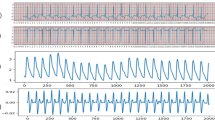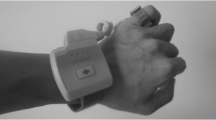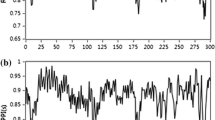Abstract
The development of a reliable and robust algorithm for prediction of syncope events is still a major challenge, especially when it is based on the analysis of the photoplethysmogram (PPG) alone. Several algorithms have been proposed in the literature based on the joint analysis of the electrocardiogram, the blood pressure and also the PPG [1]. However, when considering the analysis of the PPG alone, the ability to predict syncope events is still unsatisfactory. The aim of this work is to provide a more reliable PPG-based algorithm with higher prediction ability, using a dataset with 43 patients.
Parameters related to the chronotropic, inotropic, blood pressure, vascular tone and autonomous nervous system responses have been extracted and evaluated. Several features were computed and the most relevant were selected and ranked with a proper score system. Additionally, different algorithm setups were also tested. The best setup achieved the following results: Fm=86%, SE=100%, SP=85%, FPRh=1.9h-1 and PT= 242.3±226.9 sec.
Preview
Unable to display preview. Download preview PDF.
Similar content being viewed by others

References
1. Alshekhlee A, Shen WK, Mackall J et al., “Incidence and mortality rates of syncope in the United States,” The American journal of medicine, vol. 122, no. 2, pp. 181-188, 2009.
2. Colman N, Nahm K, Ganzeboom KS et al., “Epidemiology of reflexsyncope,” Clinical Autonomic Research, vol. 14, no. 1, pp. 9-17, 2004.
3. Lemonick DM, “Evaluation of Syncope in the emergency department,” Am J Clin Med, vol. 7, no. 1, pp. 11-9, 2010.
4. Teng XF, Zhang YT, Poon CC et al., “Wearable medical systems for p-health,” IEEE reviews in Biomedical engineering, vol. 1, pp. 62-74, 2008.
5. Virag N, Sutton R, Vetter R et al., “Prediction of vasovagal syncope from heart rate and blood pressure trend and variability: experience in 1,155 patients,” Heart Rhythm, vol. 4, no. 11, pp. 1375-1382, 2007.
6. Mereu R, De Barbieri G, Perrone T, “Heart rate/blood pressure ratio as predictor of neuromediated syncope,” International Journal of Cardiology, vol. 167, no. 4, pp. 1170-1175, 2013.
7. Piccirillo G, Camilla N, Moisè A et al., “Heart rate and blood pressure variability in subjects with vasovagal syncope,” Clinical Science, vol. 107, no. 1, pp. 55-61, 2004.
8. Eickholt C, Drexel T, Muehlsteff J et al., “Neurally mediated syncope prediction based on heart rate and pulse arrival time,” European Heart Journal, vol. 34, no. 1, p. 796, 2013.
9. Muehlsteff J, Correia T, Couceiro R et al., “Detection of hemodynamic adaptations during impending syncope: Implementation of a robust algorithm based on pulse arrival time measurements only,” 2013 35th Annual International Conference of the IEEE Engineering in Medicine and Biology Society (EMBC), pp. 2291-2294, 2013.
10. Couceiro R, Carvalho P, Paiva RP et al., “Real-Time Prediction of Neurally Mediated Syncope,” IEEE journal of biomedical and health informatics, vol. 20, no. 2, pp. 508-520, 2016.
11. Couceiro R, Carvalho P, Paiva RP et al., “Evaluation of a PPGbased algorithm for prediction of neurally mediated syncope,” 2016 IEEE-EMBS International Conference on Biomedical and Health Informatics (BHI), pp. 434-436, 2016.
12. Pinheiro N, Couceiro R, Henriques J et al., “Can PPG be used for HRV analysis?,” Engineering in Medicine and Biology Society (EMBC), 2016 IEEE 38th Annual International Conference of the, pp. 2945-2949, 2016.
13. Malik M, “Heart rate variability: Standards of measurement, physiological interpretation and clinical use,” Eur Heart J, vol. 17, pp. 354–381, 1996.
14. Qawqzeh YK, Uldis R, Alharbi M, “Photoplethysmogram second derivative review: Analysis and applications,” Scientific Research and Essays, vol. 10, no. 21, pp. 633-639, 2015.
15. Faes L, Porta A, “Conditional entropy-based evaluation of information dynamics in physiological systems,” Directed information measures in neuroscience, pp. 61-86, 2014.
Author information
Authors and Affiliations
Corresponding author
Editor information
Editors and Affiliations
Rights and permissions
Copyright information
© 2018 Springer Nature Singapore Pte Ltd.
About this paper
Cite this paper
Pinheiro, N., Couceiro, R., Muehlsteff, J., Eickholt, C., Henriques, J., Carvalho, P. (2018). Syncope Prediction using Photoplethysmography. In: Eskola, H., Väisänen, O., Viik, J., Hyttinen, J. (eds) EMBEC & NBC 2017. EMBEC NBC 2017 2017. IFMBE Proceedings, vol 65. Springer, Singapore. https://doi.org/10.1007/978-981-10-5122-7_157
Download citation
DOI: https://doi.org/10.1007/978-981-10-5122-7_157
Published:
Publisher Name: Springer, Singapore
Print ISBN: 978-981-10-5121-0
Online ISBN: 978-981-10-5122-7
eBook Packages: EngineeringEngineering (R0)



